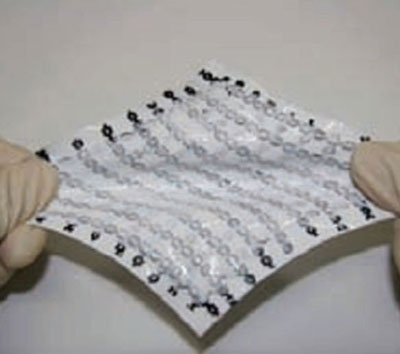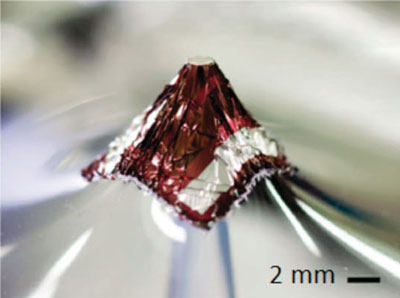| Posted: Mar 20, 2014 | |
Stretchable energy storage and conversion |
|
| (Nanowerk Spotlight) Stretchable electronics are mechanically robust electronics which can be bent, folded, crumpled and stretched and are a major research focus of nanotechnology scientists towards next-generation wearable and implantable devices. Unlike today's electronics based on rigid silicon technologies, stretchable devices can conform to almost any kind of surface shapes and provide unique functionalities which are unreachable with simple extension of conventional technologies. | |
| Already, consumer markets are showing growing interests in next-generation stretchable electronic devices like wearable health monitoring patches, implantable renal function sensors, flexible cell phones, or smart clothes with haptic actuators to control game players. | |
| In their pursuit of fully flexible and stretchable electronic devices, researchers have already reported stretchable solar cells and transistors, stretchable active-matrix displays and stretchable energy sources. The nanomaterials used for these purposes range from coiled nanowires and ionic gels ("A gel that is clearly revolutionary for stretchable electronics") to graphene ("Foaming for stretchable electronics"). | |
| Stretchable energy storage and conversion devices are key components for the fabrication of complete and independent stretchable systems. In a recent review in Small ("Stretchable Energy Storage and Conversion Devices"), researchers summarize the recent progresses in the developments of stretchable power sources including supercapacitors, batteries and solar cells. | |
| They discuss representative structural and material designs to impart stretchability to the originally rigid devices and analyze advantages and drawbacks associated with the various fabrication methods. They also present summaries of the research progresses along with future development directions. | |
| Stretchable electrodes | |
| As one of the key components for stretchable devices, the electrodes have to be able to withstand such harsh mechanical requirements. Several strategies have been used to fabricate stretchable electrodes, and in general can be categorized into the following two groups: Structures that stretch; Materials that stretch. | |
 |
|
| Rubber-like active matrix from fluoride copolymer and SWCNT composite elastic conductors. (© AAAS) | |
| Creating structures that can be stretched is the most successful strategy for stretchable electronics, and the stretchable structures can be categorized into the following four types: Non-coplanar buckled structures; Coplanar serpentine structures; Percolating nanostructured films; Textiles. | |
| Materials that stretch are mainly based on polymers with flexible and stretchable molecular chains. Composites based on organic polymers and inorganic structures such as nanowires and nanoparticles are categorized as stretchable structures since functional inorganic components are rigid and the stretchability originates from the percolating structure. | |
| Stretchable supercapacitor | |
| Most commonly used active materials for double-layer supercapacitors are carbon-based materials such as single-walled carbon nanotubes (SWCNTs), graphene and mesoporous carbon, due to their excellent electrical conductivity and high surface areas. The carbon-based materials are also natural choices for stretchable supercapacitors, with proper structural engineering to impart stretchability to the devices (see for instance: "Power sources for flexible, stretchable electronics"). | |
| Another strategy to fabricate stretchable supercapacitors is to use the stretchable characteristics of textiles (see for instance: "Wearable textile battery can be recharged by sunlight"). | |
| Stretchable double-layer supercapacitors based on SWCNTs films on both elastic PDMS substrates and textile substrates have excellent stretchability, electrochemical and mechanical stability. However, the key drawback of those double-layer devices is the low specific capacitance and energy density and this can potentially be improved by the incorporation of redox materials. | |
| Stretchable batteries | |
| The authors review several fabrication techniques for stretchable dry (zinc carbon) batteries, magnesium batteries, lithium-ion batteries, alkaline batteries, and silver-zinc batteries. | |
| Stretchable solar cells | |
| Inorganic solar cells are more efficient but also more expensive than organic solar cells. While crystalline silicon is by far the most prevalent materials for solar cells, other common inorganic material options include cadmium telluride (CdTe), copper indium gallium selenide (CIGS), gallium arsenide (GaAs), indium gallium nitride (InGaN) and dye-sensitized solar cells (DSSCs). The fabrication of stretchable inorganic solar cells based on GaAs microcells with buckled Au interconnects has already been reported. | |
 |
|
| Ultrathin solar cell on a plastic tip with 1.5 mm diameter. (© Nature Publishing Group) | |
| Compared with inorganic solar cells, soft organic solar cells usually have inferior performances and poor environmental stability. But they are advantageous in terms of low costs, structural flexibility and ease of production from solution processes. The soft, flexible and stretchable characteristics of organic polymers allow ready construction of stretchable solar cells. | |
| The authors conclude their review with the forecast that continuous developments will go from individual discrete components and devices (such as stretchable power sources) to integrated complex systems. "With the growing interest from both academic and industrial areas, breakthroughs in discrete components and devices can be readily expected. Integration and coordination of those functional devices into complete systems will pave the way for practical applications." | |
 By
Michael
Berger
– Michael is author of three books by the Royal Society of Chemistry:
Nano-Society: Pushing the Boundaries of Technology,
Nanotechnology: The Future is Tiny, and
Nanoengineering: The Skills and Tools Making Technology Invisible
Copyright ©
Nanowerk LLC
By
Michael
Berger
– Michael is author of three books by the Royal Society of Chemistry:
Nano-Society: Pushing the Boundaries of Technology,
Nanotechnology: The Future is Tiny, and
Nanoengineering: The Skills and Tools Making Technology Invisible
Copyright ©
Nanowerk LLC
|
|
|
Become a Spotlight guest author! Join our large and growing group of guest contributors. Have you just published a scientific paper or have other exciting developments to share with the nanotechnology community? Here is how to publish on nanowerk.com. |
|
